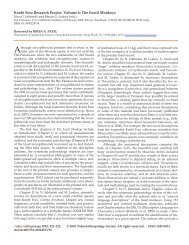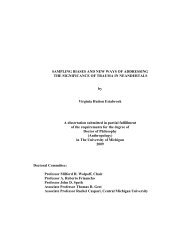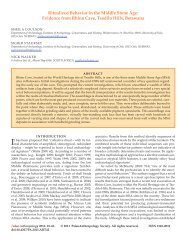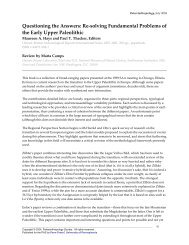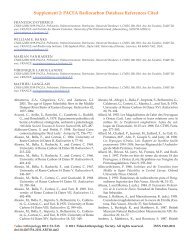PDF (12134 K) - Paleoanthropology Society
PDF (12134 K) - Paleoanthropology Society
PDF (12134 K) - Paleoanthropology Society
You also want an ePaper? Increase the reach of your titles
YUMPU automatically turns print PDFs into web optimized ePapers that Google loves.
that a number of individuals co-operated in the performance<br />
of the acquisition and this led to the interpretation<br />
of a specific task group being present here (Van Peer 2001:<br />
58). The latest evidence would even seem to suggest that<br />
specialist chert knappers were among this party (Van Peer<br />
2007).<br />
At Taramsa-1, it is clear that the Upper Pleistocene extraction<br />
pits and ditches were cut through older features,<br />
destroying them in the process. Up until now, no early<br />
workshop situation has been found in primary context<br />
here. In early 2003, a three-day preliminary excavation was<br />
carried out at the newly discovered site of Taramsa-8, situated<br />
on an isolated hill of similar appearance to Taramsa-<br />
1 and a few kilometers to the south of it. The presence of<br />
a strongly weathered desert pavement consisting of large<br />
chert blocks and artifacts including a few bifacial foliates,<br />
suggested that old, i.e., older than those at Taramsa-1, undisturbed<br />
contexts might be recovered. Test trenches in<br />
various areas of the hill confirmed that Paleolithic extraction<br />
features were indeed present.<br />
In this paper, we present the wear analysis results on<br />
a broken lanceolate point found within one of these features.<br />
We furthermore discuss some possible implications<br />
of this item in its context, with reference to the socio-economic<br />
organization described above and to the emergence<br />
of behavioral complexity in the earlier Middle Paleolithic of<br />
northeast Africa.<br />
ConTExT of TARAMSA-8<br />
In a section at the eastern side of the hill, resulting from<br />
Analysis and Interpretation of a Lanceolate Point • 235<br />
Figure 1. Section of the prehistoric extraction pit at Taramsa-8.<br />
recent mechanical quarrying activities, an apparent prehistoric<br />
ditch was visible (Figures 1 and 2). Starting from this<br />
section, we set out to retrieve and excavate its horizontal<br />
extension. The lanceolate point, broken into two fragments<br />
lying some 20cm apart, was found in the top of coarse<br />
sands underneath 20cm of slope wash deposits, in association<br />
with its production flakes. Several of the latter were<br />
refitted onto the basal part of the point. Typologically, the<br />
upper level point is reminiscent of the bifacial foliates that<br />
are present in early Nubian Complex assemblages such as<br />
those from Bir Tarfawi (Wendorf et al. 1993). At the same<br />
time, a vertical excavation of the section was performed.<br />
At the base of the fill deposits of the prehistoric ditch, another<br />
lanceolate fragment and a bifacial axe with a wide<br />
bit, somewhat reminiscent of a core-axe, were found. The<br />
lanceolate fragment represents the distal part only and it<br />
fractured during initial shaping. The fracture was initiated<br />
from the central dorsal ridge on one face and it terminates<br />
on the opposite face in a distinct feather. Fine regular retouch<br />
that “smooths” the edges is absent.<br />
The presence of artifacts in various stratigraphic positions<br />
demonstrates that the mining activities at this spot<br />
were intermittent, but probably within a rather restricted<br />
period of time. The physical appearance of the uppermost<br />
artifacts, in absolutely fresh condition but showing a deep<br />
reddish-yellow patina, indicates that they are likely to be<br />
of Middle Pleistocene or early Upper Pleistocene age. At<br />
nearby Taramsa-1, later Pleistocene artifacts never show<br />
any patination at all. On the contrary, those recovered from<br />
reworked, secondary contexts such as at Sector 91/06 have



